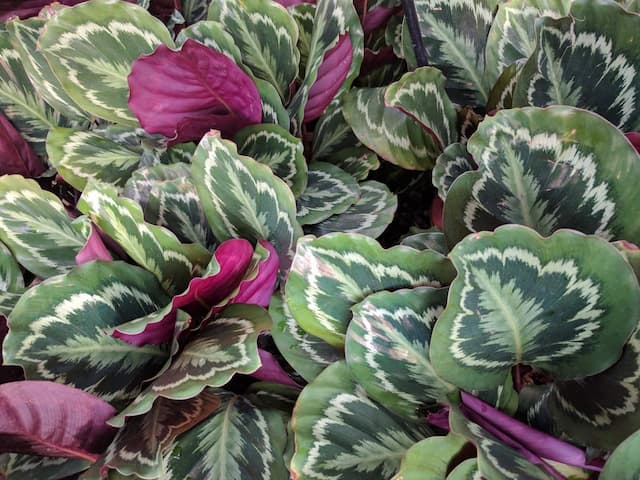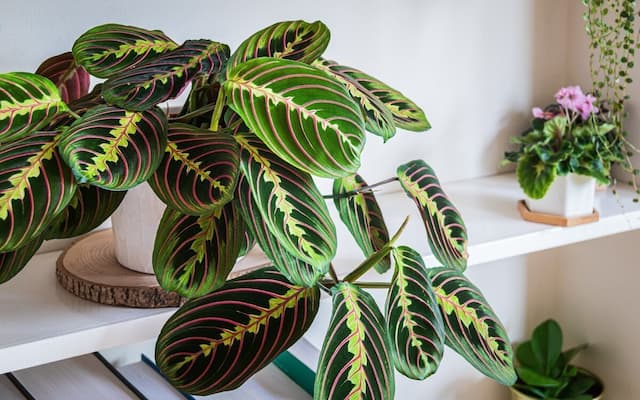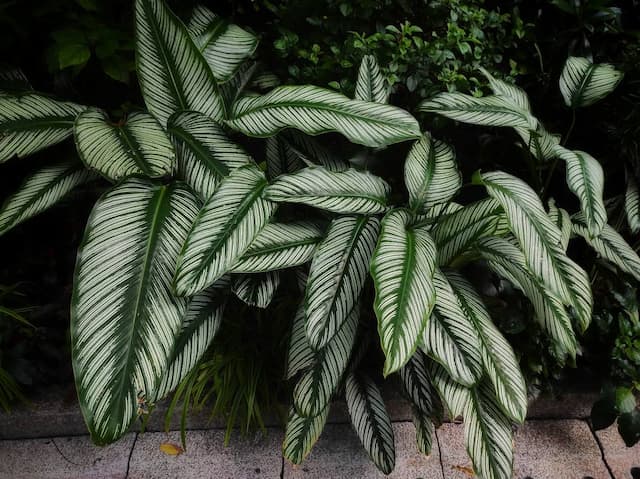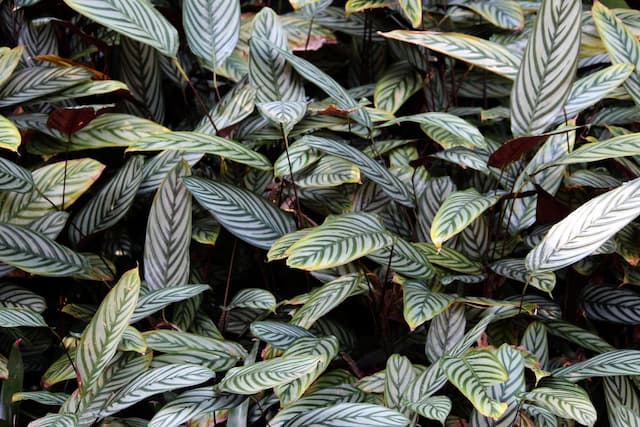Calathea concinna Goeppertia concinna

ABOUT
The plant commonly known as the "Velvet Calathea" or "Never-Never Plant" is a visually striking houseplant with a lush and tropical appearance. It boasts broad, oval-shaped leaves that are a dark green on the top, featuring a velvety texture and beautiful patterns. The patterns are often a lighter green, which create a striking contrast against the darker foliage. The undersides of the leaves are equally stunning, displaying a rich purple tone that adds to the visual interest of the plant. The Velvet Calathea has leaves that grow on long, slender stems which gracefully arch outward from the central base of the plant. The overall look of the plant is elegant and sophisticated, with a vibrant, almost painted appearance that can add a pop of color and texture to any indoor space. This plant is known for its interesting leaf movements, as it raises and lowers its leaves from day to night as a part of its natural rhythm, further adding to its dynamic character. While the Velvet Calathea is admired for its decorative leaves, it does not typically produce showy flowers when kept indoors, which keeps the focus on its stunning foliage. The plant's harmonious color palette and unique leaf patterns make it a popular choice for those looking to incorporate a touch of nature's artistry into their home decor.
About this plant
 Names
NamesFamily
Asparagaceae
Synonyms
Red-Edged Dracaena, Dragon Tree, Madagascar Dragon Tree
Common names
Calathea concinna, Phrynium concinnum.
 Toxicity
ToxicityTo humans
The plant commonly known as Calathea does not have significant toxicity to humans. It is generally considered non-toxic, and ingestion of this plant is not known to cause serious harm or symptoms.
To pets
The Calathea plant is also non-toxic to pets such as cats and dogs. If ingested by pets, it is unlikely to cause any severe symptoms or health issues. However, as with any non-food item, ingestion of large amounts can potentially cause mild gastrointestinal upset or discomfort in some animals.
 Characteristics
CharacteristicsLife cycle
Perennials
Foliage type
Evergreen
Color of leaves
Variegated
Height
2 feet [60 cm]
Spread
2 feet [60 cm]
Plant type
Herb
Hardiness zones
11
Native area
South America
Benefits
 General Benefits
General Benefits- Decorative Appeal: Adds a touch of greenery and visual interest to indoor spaces with its bold, patterned foliage.
- Humidity Tolerance: Thrives in a range of indoor humidity levels, making it suitable for many home environments.
- Low Light Adaptation: The plant can grow in low-light conditions, which is ideal for spaces with limited natural light.
- Easy Propagation: Can be easily propagated from stem cuttings, allowing for the creation of new plants.
- Minimal Maintenance: Requires little care beyond basic watering and occasional feeding, making it convenient for busy individuals.
- Growth Habit: Its compact size and slow growth rate make it an excellent choice for smaller spaces such as apartments and offices.
 Medical Properties
Medical PropertiesThis plant is not used for medical purposes.
 Air-purifying Qualities
Air-purifying QualitiesThis plant is not specifically known for air purifying qualities.
 Other Uses
Other Uses- The leaves of the Calathea concinna can be used as a natural dye for fabrics, producing a range of earthy tones depending on the mordant used.
- The plant can be a subject for botanical illustration and art classes, where students can practice capturing its intricate leaf patterns and colors.
- Calathea concinna can be utilized in terrariums and vivariums, providing a lush, tropical backdrop for small reptiles and amphibians.
- Small, crafty objects like bookmarks or greeting cards can be decorated with pressed leaves of the Calathea concinna for a botanical flair.
- Due to its striking appearance, the plant can be employed in photography and staging for interior design magazines and websites.
- As an educational tool, Calathea concinna can help teach children and adults about plant care and tropical ecosystems in schools or workshops.
- The plant's leaves can be used in flower arrangements or as a temporary natural table decor for tropical-themed events.
- Calathea concinna can be used in sensory gardens, providing a visually stimulating element with its contrasting leaf patterns that change position from day to night.
- In film and theater productions, Calathea concinna could be incorporated into set designs to portray tropical or exotic locations.
- The plant could play a role in cultural studies, exploring its significance in the horticultural practices and aesthetics of its native regions.
Interesting Facts
 Feng Shui
Feng ShuiThe Calathea is not used in Feng Shui practice.
 Zodiac Sign Compitability
Zodiac Sign CompitabilityThe Calathea is not used in astrology practice.
 Plant Symbolism
Plant Symbolism- Elegance and Beauty: The Goeppertia concinna, commonly known as the Calathea, is admired for its attractive patterned leaves which symbolize beauty and the appreciation for nature's artistry.
- Balance: With its symmetrical leaf patterns and stable growth habit, the Calathea represents balance and harmony in life.
- Spirituality: Often used in spiritual ceremonies and practices, Calathea signifies a connection to the divine and enhancing spiritual growth.
- Privacy: The movement of Calathea leaves, which open and close from day to night, is seen as a symbol of privacy and the idea that everyone has their moment to shine.
 Water
WaterThe Calathea concinna should be watered regularly to keep the soil consistently moist but not waterlogged. It is best to water this plant when the top inch of the soil feels dry to the touch, which typically means watering about once a week. Depending on the size of your pot, this could mean using approximately 8 to 16 ounces of water each time. Adjust the frequency based on the humidity and temperature conditions of your home, watering more often during the warmer months and less during cooler, less active growth periods.
 Light
LightThe Calathea concinna thrives in medium to low indirect light conditions. It's best to place it in a spot where it will receive bright, indirect sunlight, such as near an east or north-facing window. Direct sunlight should be avoided as it can scorch the leaves.
 Temperature
TemperatureThe ideal temperature range for Calathea concinna is between 65°F and 80°F. It can endure a minimum temperature of 60°F and a maximum of 85°F. To maintain healthy growth, try to keep the plant in an environment that does not fluctuate too much from these ideal conditions.
 Pruning
PruningPruning Calathea concinna helps to keep the plant looking tidy and encourages new growth. Trim away yellow or brown leaves at the base of the stem with clean, sharp scissors, and do so as needed throughout the year. The best time for extensive pruning is during the spring or early summer when the plant is actively growing.
 Cleaning
CleaningAs needed
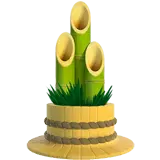 Soil
SoilThe Calathea concinna prefers a well-draining soil mix consisting of a balance of peat, perlite, and potting soil. Optimal soil pH is slightly acidic to neutral, ranging from 6.0 to 7.0.
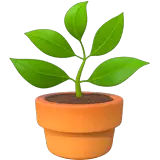 Repotting
RepottingCalathea concinna should be repotted every 1-2 years or when it outgrows its pot, ideally during the springtime.
 Humidity & Misting
Humidity & MistingCalathea concinna thrives in high humidity levels, ideally between 60% and 80%, to maintain its lush foliage.
 Suitable locations
Suitable locationsIndoor
Place Calathea concinna in indirect light, keep soil moist, and maintain high humidity.
Outdoor
Grow Calathea concinna in shade, shelter from wind, with warm temps and high humidity.
Hardiness zone
11-12 USDA
 Life cycle
Life cycleThe Goeppertia concinna, commonly known as the Calathea concinna, begins its life cycle as a seed, requiring warm, moist conditions to germinate. After germination, the seedling emerges and starts to develop its characteristic patterned leaves, entering the vegetative growth stage where it invests energy into leaf and root development. As a perennial, the plant does not have a distinct flowering stage visible to the casual observer, but under ideal conditions, it may produce inconspicuous flowers. The Calathea concinna continues to grow, periodically producing new leaves from its central clump, and can also propagate vegetatively through division of its rhizome. In its mature stage, the plant maintains its size and shape through the continual replacement of older leaves with new growth. It completes its life cycle when it eventually succumbs to age or environmental stresses, but offsets or divisions can continue its genetic line.
 Propogation
PropogationPropogation time
Spring to Summer
The Goeppertia concinna, commonly known as the Calathea concinna, is best propagated during its active growth period in the spring and summer. The most popular method of propagation is by division of the plant's rhizomes. To propagate by division, gently remove the plant from its pot and shake off the excess soil, allowing you to see the natural divisions of the rhizome. Use a clean, sharp knife or pair of scissors to cut through the rhizome, ensuring each division has at least one or two healthy shoots and some roots. Plant each division in a small pot filled with a well-draining potting mix, ideally one that is peat-based. Keep the soil consistently moist, but not soggy, and place the pots in a warm location with indirect light. After a few weeks, the divisions should start to establish themselves and new growth will be observed.
